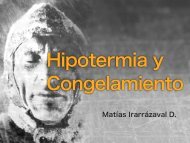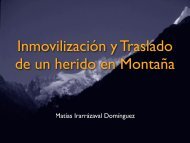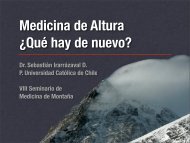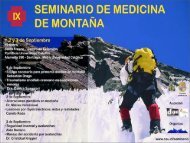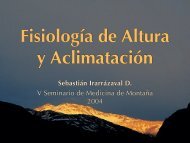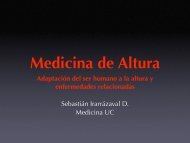Lesiones En Ski – Negrin - Seminario de Medicina de Montaña
Lesiones En Ski – Negrin - Seminario de Medicina de Montaña
Lesiones En Ski – Negrin - Seminario de Medicina de Montaña
Create successful ePaper yourself
Turn your PDF publications into a flip-book with our unique Google optimized e-Paper software.
<strong>Lesiones</strong> en ski<br />
• Dr Roberto <strong>Negrin</strong> Vyhmeister
• La Sociedad Chilena <strong>de</strong> <strong>Medicina</strong> <strong>de</strong>l<br />
Deporte, fundada el 18 <strong>de</strong> julio <strong>de</strong><br />
1955,está 1955,est constituida por mas <strong>de</strong> 400<br />
médicos dicos y profesionales <strong>de</strong>dicados a la<br />
educación educaci n y difusión difusi n <strong>de</strong> la medicina<br />
<strong>de</strong>portiva
WWW.SOCHMEDEP.CL
Historia <strong>de</strong>l esquí esqu<br />
• Historiadores Griegos: Pieles, patines o<br />
zapatos especiales<br />
• Mitología Mitolog a nórdica: n rdica: primeros esquís esqu s en<br />
pantanos suecos y finlan<strong>de</strong>ses, 4000 a<br />
5000 años a os <strong>de</strong> antigüedad<br />
antig edad<br />
• Armazones alargados ,anchos,<br />
cubiertos por pieles
Classic Norwegian painting<br />
of 2-year 2 year old prince Häkon kon<br />
being taken to safety in<br />
Osterdalen from Lillehammer<br />
in 1206.
Era mo<strong>de</strong>rna <strong>de</strong>l esquí: esqu : Europa<br />
• Mediados <strong>de</strong>l siglo XIX : Noruega<br />
• 1850: esquí esqu camber en la provincia <strong>de</strong><br />
Telemark<br />
• 1850-1860 1850 1860 : primeras carreras<br />
• 1868: Sondre Norheim crea el esquí esqu si<strong>de</strong>cut<br />
(más (m s angosto bajo el pie)<br />
• 1880: Noruega, primer esquí esqu <strong>de</strong> Nogal<br />
americano, más m s flexible y resistente.<br />
Se exporta a gran escala <strong>de</strong>s<strong>de</strong> Louisiana
Era mo<strong>de</strong>rna <strong>de</strong>l esquí esqu<br />
• 1887: inmigrantes noruegos se instalan en<br />
Wisconsin y Minnesota<br />
• 1893: H.M. Christiansen, en Noruega, Noruega,<br />
construye el<br />
primer esquí esqu laminado <strong>de</strong> dos capas<br />
• 1905: una unidad alpina <strong>de</strong>l ejército ej rcito francés, franc , lleva<br />
acabo la primera producción producci en serie <strong>de</strong> esquíes esqu es<br />
estilo Telemark, Telemark,<br />
en Briancon, Briancon,<br />
Francia. Francia<br />
• 1928: El bor<strong>de</strong> <strong>de</strong> acero segmentado,<br />
segmentado,<br />
inventado por<br />
Rudolph Lettner <strong>de</strong> Salzburgo, Salzburgo,<br />
Austria, da al esquí esqu<br />
mejor agarre en nieve dura manteniendo la<br />
flexibilidad natural <strong>de</strong> la ma<strong>de</strong>ra
Cross-country <strong>Ski</strong>ing<br />
Freestyle <strong>Ski</strong>ing<br />
Alpine <strong>Ski</strong>ing<br />
Telemark <strong>Ski</strong>ing
Speed <strong>Ski</strong>ing<br />
<strong>Ski</strong> Jumping
Roller <strong>Ski</strong>ing<br />
Grass <strong>Ski</strong>ing<br />
Heli <strong>Ski</strong>ing
Esquí Esqu Alpino<br />
• Des<strong>de</strong> 1970 la tasa <strong>de</strong> lesiones ha<br />
disminuido en 50%<br />
• 2 a 4 lesiones por 1000 esquiadores por día d<br />
Columbia Británica Brit nica
Tasa <strong>de</strong> Inci<strong>de</strong>ncia<br />
• 1959 Moritz : 7,6 esquiadores / 1000 ds /<br />
ski.<br />
• 1962 Haddon : 5,9 “ “<br />
• 1989 Johnson : 2,0 “ “<br />
– Disminución Disminuci n inci<strong>de</strong>ncia lesiones EEII.<br />
– Disminución Disminuci n lesiones tobillo y pierna.<br />
– Se mantiene % lesiones <strong>de</strong> rodilla.
INCIDENCIA DE LESIONES DE LA<br />
NCAA(1996) L/1000 EA<br />
• FUTBOL 9.8<br />
• BASQUETBOL 5.7<br />
• VOLEYBOL 4.8<br />
• LUCHA 9.6<br />
• GIMNASIA 9.3<br />
• BASEBALL 3.4<br />
• HOCKEY 5.5<br />
• SKI 4.2
<strong>Lesiones</strong> en el esquí esqu alpino<br />
• Esta disminución disminuci n en la tasa<br />
<strong>de</strong> lesiones está est<br />
directamente relacionado<br />
con el <strong>de</strong>sarrollo <strong>de</strong> los<br />
equipos<br />
• Nuevos sistemas <strong>de</strong><br />
liberación liberaci n <strong>de</strong> fijaciones y<br />
zapatos plásticos pl sticos<br />
disminuyen notablemente<br />
luxofracturas <strong>de</strong> tobillo y<br />
fracturas <strong>de</strong> pierna<br />
• Frenos <strong>de</strong> esquí esqu disminuyen<br />
heridas cortantes
Esquí Esqu alpino
Esquí Esqu alpino
<strong>Ski</strong>boarding (snowblading<br />
( snowblading)<br />
• El advenimiento <strong>de</strong>l snowboard, seguido por la<br />
creciente popularidad <strong>de</strong>l ski telemark en pista, pista,<br />
ha<br />
roto el monopolio <strong>de</strong>l esquí esqu alpino en los últimos ltimos 10<br />
años os<br />
• <strong>En</strong> los últimos ltimos 3 años os, , el skiboard ha emergido y se<br />
ha establecido como <strong>de</strong>porte <strong>de</strong> nieve in<strong>de</strong>pendiente<br />
• Su precursor fué fu el BigFoot, BigFoot,<br />
fabricado por Kneissl<br />
Dachstein,en 1991.<br />
• Utiliza zapatos convencionales, convencionales,<br />
con fijaciones que<br />
no se liberan
<strong>Ski</strong>board (snowbla<strong>de</strong><br />
snowbla<strong>de</strong>)<br />
• Son mejor <strong>de</strong>scritos como mini esquíes esqu es, , mi<strong>de</strong>n menos <strong>de</strong> 1<br />
metro<br />
• Alto grado <strong>de</strong> maniobravilidad<br />
• Permiten andar hacia atrás atr<br />
• Giros <strong>de</strong> 180 o 360 grados o más<br />
• Rápida pida alza en popularidad especialmente en jóvenes venes<br />
(hombres)<br />
• No utiliza bastones<br />
• Menos caros<br />
• Fáciles ciles <strong>de</strong> llevar
The Original BigFoot<br />
Salomon SnowBla<strong>de</strong> Buzz 9.0<br />
Salomon SnowBla<strong>de</strong> Grom<br />
skiboard
LESIONES DE RODILLA<br />
• LESIONES<br />
LIGAMENTOSAS<br />
• LESIONES OSEA<br />
• LESIONES<br />
MENISCALES<br />
• LESIONES<br />
OSTEOCONDRALES<br />
• SOBREUSO
LESIONES DE RODILLA<br />
• LIG. MEDIAL.<br />
• LESIÓN LESI N LCA.<br />
• COMBINADA.<br />
• LIG. LATERAL.<br />
• MENISCAL.<br />
• FRACTURA PLATILLO TIBIAL.<br />
• SOBRECARGA:<br />
SOBRECARGA<br />
CONDROMALACIA.<br />
TENDINOSIS ROTULIANA.
ESGUINCE MEDIAL DE RODILLA<br />
• Lesión Lesi n más m s<br />
frecuente.<br />
• Por caída. ca da.<br />
• Valgo forzado.<br />
• Pue<strong>de</strong> ser<br />
combinada.
ESGUINCE MEDIAL<br />
�� DG (CLINICO-EX.)<br />
(CLINICO EX.)<br />
�� GRADOS I-II I II-III III<br />
�� GRADO III<br />
�� TTO. ORTOPEDICO<br />
FUNCIONAL<br />
�� RETORNO DEPORTIVO<br />
75 DIAS
• DESACELERACION SIN<br />
CONTACTO<br />
(MECANISMO MAS FRECUENTE)<br />
• HEMARTROSIS (90%)<br />
• SENSACION DE CRUJIDO (50%)<br />
EXAMEN FISICO:<br />
LESION LCA - DG<br />
• LACHMAN, CAJON ANTERIOR, PIVOT<br />
SHIFT<br />
EXAMENES:<br />
• RX<br />
• RNM (95%)
<strong>Lesiones</strong> <strong>de</strong> LCA<br />
• Des<strong>de</strong> 1970 hasta el inicio <strong>de</strong> 1990<br />
aumentaron en 240%<br />
• Esto se le atribuyó atribuy inicialmente a la no<br />
liberación liberaci n <strong>de</strong> las fijaciones<br />
• La inci<strong>de</strong>ncia <strong>de</strong> lesiones <strong>de</strong> LCA<br />
permaneció permaneci estática est tica durante las siguiente 10<br />
temporadas<br />
• <strong>En</strong> el congreso ISSS 2003 fue reportada<br />
ten<strong>de</strong>ncia inicial, a <strong>de</strong>clinar, en Francia.
Mo<strong>de</strong>lo <strong>de</strong> esquí esqu y lesión lesi n <strong>de</strong><br />
• Esquís Esqu s convencionales<br />
(largos), y<br />
fundamentalmente su cola<br />
sería ser a la responsable <strong>de</strong>l<br />
mecanismo <strong>de</strong>l pie fantasma<br />
• El skiboard utiliza esquís esqu s<br />
cortos y por lo tanto no se<br />
produciría producir a este mecanismo<br />
lesional<br />
• El esquí esqu carving, carving,<br />
más m s corto,<br />
con mejor control <strong>de</strong> giro,<br />
cada vez más m s en uso,<br />
pudiera disminuir la<br />
inci<strong>de</strong>ncia <strong>de</strong> lesiones <strong>de</strong><br />
LCA<br />
LCA
Factores que predisponen Phantom Foot<br />
• Intentar pararse cuando se esta en<br />
movimiento luego <strong>de</strong> una caída ca da<br />
• Intentar recuperarse <strong>de</strong> una perdida <strong>de</strong><br />
balance<br />
• Tratar <strong>de</strong> sentarse cuando se pier<strong>de</strong> el<br />
control
Mecanismo Boot Induced<br />
• Se produce cuando el<br />
esquiador pier<strong>de</strong> el<br />
balance y se va hacía hac a<br />
atrás atr s<br />
• Instintivamente<br />
extien<strong>de</strong> las rodillas<br />
• Bota ejerce fuerza<br />
sobre la tibia que<br />
rompe al LCA<br />
• Produce un cajón caj n<br />
anterior
Evitar conductas riesgosas <strong>de</strong> lesión lesi n <strong>de</strong><br />
LCA<br />
• No exten<strong>de</strong>r las piernas al<br />
caer , mantenerlas<br />
semiflectadas<br />
• No tratar <strong>de</strong> pararse cuando<br />
se esta aun <strong>de</strong>slizando<br />
• Llevar los brazos y manos al<br />
frente<br />
• No saltar si no se sabe como<br />
y don<strong>de</strong> caer , si se salta<br />
caer en ambos esquís esqu s con<br />
las piernas semiflectadas
A method to help reduce the risk of serious knee<br />
sprains incurred in alpine skiing<br />
Ettlinger,Carl et al AJ Sport Medic 1995<br />
• Trabajo realizado en Vermontt<br />
• Se revisaron 8 años a os <strong>de</strong> vi<strong>de</strong>os<br />
<strong>de</strong> acci<strong>de</strong>ntes <strong>de</strong> ski<br />
• Se i<strong>de</strong>ntificaron dos<br />
mecanismos <strong>de</strong> producción producci n <strong>de</strong><br />
lesiones <strong>de</strong> LCA<br />
• Se seleccionó seleccion a la población poblaci n<br />
patrullas <strong>de</strong> ski<br />
• Se seleccionó seleccion un grupo control<br />
similar <strong>de</strong> otra área rea <strong>de</strong> ski
A method to help reduce the risk of serious knee<br />
sprains incurred in alpine skiing<br />
Ettlinger,Carl et al AJ Sport Medic 1995<br />
El estudio contaba <strong>de</strong> una fase <strong>de</strong> entrenamiento con vi<strong>de</strong>o <strong>de</strong><br />
mecanismos y prevención prevenci n <strong>de</strong> lesiones<br />
Se entrenaba a los seleccionados en i<strong>de</strong>ntificación i<strong>de</strong>ntificaci n <strong>de</strong> las<br />
conductas peligrosas<br />
Se logro bajar en un 62 % la ocurrencia <strong>de</strong> lesiones <strong>de</strong><br />
LCA comparado a la misma población poblaci n en los dos<br />
años os anteriores<br />
<strong>En</strong> el grupo control que no hubo entrenamiento no <strong>de</strong>clinaron las<br />
lesiones respecto a los dos años a os anteriores
Ahlbaumer G, Vogt W and <strong>En</strong>gel H. The protective<br />
value of a rear release ski boot. boot.<br />
Presented at the 14th<br />
International Congress on <strong>Ski</strong> Trauma and <strong>Ski</strong>ing<br />
Safety, Safety,<br />
Queenstown,<br />
Queenstown,<br />
New Zealand August 2001. 2001<br />
• Se introduce una bota<br />
que tiene un<br />
mecanismo protector<br />
<strong>de</strong> LCA<br />
• Mecanismo se suelta<br />
cuando se aplica<br />
mucha fuerza en su<br />
parte posterior<br />
• Se reengancha cuando<br />
se recupera el balance
Effect of alpine ski boot cuff release on knee<br />
joint force during the backward fall<br />
D.L.Benoit et al<br />
Research in sport medicine , 13 2005
LESIONES MENISCALES<br />
• Mecanismo: torsión torsi n -<br />
rotación rotaci<br />
• Dolor interlinea, <strong>de</strong>rrame<br />
leve,<br />
dolor en rotación, rotaci n, no un<br />
plano.<br />
• Dg. clínica cl nica y ex. físico f sico<br />
• EX: RNM<br />
• TTO: Quirúrgico<br />
Quir rgico<br />
(mayoría) (mayor a)
<strong>Lesiones</strong> Meniscales
<strong>Lesiones</strong> Meniscales
FRACTURAS PLATILLOS TIBIALES<br />
• POCO FRECUENTE.<br />
• POR CAIDA O CHOQUE.<br />
• MUCHAS SON<br />
QUIRURGICAS.
LESIONES POR SOBREUSO RODILLA<br />
Trastorno Patelofemoral<br />
• Condición Condici n anatómica anat mica y funcional<br />
• Fondistas, ciclistas, SKI.<br />
• Factores predisponentes<br />
– Biomecánica Biomec nica anormal<br />
– Acortamiento partes blandas<br />
– Desbalance muscular<br />
– <strong>En</strong>trenamiento
LESIONES LESIONES POR POR SOBREUSO SOBREUSO RODILLA<br />
RODILLA<br />
Trastorno<br />
Patelofemoral<br />
• Acortamiento partes blandas<br />
– Retináculo Retin culo lateral<br />
– Banda iliotibial<br />
– Recto femoral<br />
– Isquitibiales<br />
– Qastrocnemio
LESIONES POR SOBREUSO RODILLA<br />
Trastorno Patelofemoral<br />
• Desbalance muscular<br />
– Vasto oblicuo medial<br />
– Abductores ca<strong>de</strong>ra<br />
– Rotadores externos<br />
(glúteo (gl teo medio posterior)
LESIONES POR SOBREUSO RODILLA<br />
Trastorno Patelofemoral<br />
• <strong>En</strong>trenamiento<br />
– Brusco incremento en distancia<br />
– Incremento trabajo pendientes<br />
– Cambio <strong>de</strong> superficie<br />
– POSICIÓN POSICI N MANTENIDA SEMIFLEXIÓN<br />
SEMIFLEXI
<strong>Lesiones</strong> específicas:<br />
espec ficas: hombro<br />
• Representan el 4%<br />
<strong>de</strong> las lesiones:<br />
– Fractura <strong>de</strong> clavícula clav cula<br />
y húmero h mero proximal.<br />
– Luxación Luxaci n anterior <strong>de</strong><br />
hombro.<br />
– <strong>Lesiones</strong><br />
acromioclaviculares.<br />
acromioclaviculares
<strong>Lesiones</strong> específicas: columna<br />
• Inci<strong>de</strong>ncia <strong>de</strong> lesiones <strong>de</strong> columna:<br />
0,01 por 1000 esquiadores día.<br />
• Saltos > 2 metros es la causa <strong>de</strong><br />
lesión en 20% <strong>de</strong> esquiadores.<br />
• No hay una inci<strong>de</strong>ncia mayor en<br />
niños.
<strong>Lesiones</strong> específicas:<br />
espec ficas: mano<br />
• Esquí Esqu es la causa más s frecuente<br />
<strong>de</strong> lesión lesi n aguda <strong>de</strong>l ligamento<br />
colateral ulnar <strong>de</strong>l pulgar. pulgar<br />
Caída Ca da sin bastón bast n (colateral radial) Caída Ca da con bastón bast n (colateral ulnar)<br />
ulnar
<strong>Lesiones</strong> específicas:<br />
espec ficas:<br />
mortalidad<br />
• 14% <strong>de</strong> todas las muertes por<br />
esquí esqu ocurren en niños ni os.<br />
• <strong>En</strong>tre 10 – 17 años os.<br />
• Principalmente por choque<br />
directo (árboles rboles). ).<br />
• Etiología: Etiolog<br />
–TEC TEC grave.<br />
–Trauma Trauma multiorgánico<br />
multiorg nico.
• Es mas peligroso el ski o<br />
el snowboard ?
Temporada 1996, <strong>de</strong>but <strong>de</strong>l SNOWBOARD en B&B<br />
Temporada 1999, aparecen los esquis CARVER<br />
2000<br />
1800<br />
1600<br />
1400<br />
1200<br />
1000<br />
800<br />
600<br />
400<br />
200<br />
0<br />
1995/96 1997/98 1999/00 2001/02 2003/04<br />
Alpine ski<br />
Carving ski<br />
Snowboard<br />
Cross country
TEMPORADAS 2000 a 2006<br />
ESQUI ALPINO SNOWBOARD<br />
Edad media 35 Edad media 25<br />
47%<br />
53%<br />
28%<br />
72%<br />
Masculino Femenino
1400<br />
1200<br />
1000<br />
800<br />
600<br />
400<br />
200<br />
DISTRIBUCIÓN DISTRIBUCI N POR SEXOS<br />
ESQUI ALPINO SNOWBOARD<br />
0<br />
1999/00 2000/01 2001/02 2002/03 2003/04 2004/05 2005/06<br />
Male Female<br />
350<br />
300<br />
250<br />
200<br />
150<br />
100<br />
50<br />
0<br />
1999/00 2000/01 2001/02 2002/03 2003/04 2004/05 2005/06<br />
Male Female
Temporadas 2000 a 2006<br />
<strong>Lesiones</strong> en Total<br />
81%<br />
19%<br />
<strong>Lesiones</strong> en<br />
adolescentes<br />
adolescentes (menos <strong>de</strong><br />
16 a.)<br />
76%<br />
24%<br />
ESQUI ALPINO Y CARVER<br />
SNOW BOARD
LESIONES SEGÚN SEG N<br />
PATOLOGÍA<br />
PATOLOG<br />
ESQUI & SNOWBOARD
COMPARATIVO, E.E.I.I. E.E.I.I.<br />
& E.E.S.S. E.E.S.S<br />
temporadas 2000 a 2006<br />
ESQUÍ ESQU ALPINO SNOWBOARD<br />
7879<br />
8252<br />
EXTREM.<br />
INFERIORES<br />
EXTREM.<br />
SUPERIORES<br />
2121<br />
795
COLISIONES :<br />
ESQUÍ ESQU & SNOWBOARD
162<br />
863 799 contra un objeto<br />
63<br />
43<br />
99<br />
contra un esquiador<br />
contra un snowboar<strong>de</strong>r
70%<br />
60%<br />
50%<br />
40%<br />
30%<br />
20%<br />
10%<br />
0%<br />
PROBABILIDAD DE LESIÓN LESI N<br />
SEGÚN SEG N EL NIVEL TÉCNICO T CNICO<br />
25%<br />
65%<br />
10%<br />
30%<br />
55%<br />
15%<br />
ESQUÍ ALPINO SNOW BOARD<br />
Edad media 35 Edad media 25<br />
PRINCIPIANTES<br />
INICIADOS<br />
EXPERTOS
LESIONES MÁS M S TÍPICAS T PICAS <strong>de</strong>l ESQUÍ. ESQU<br />
Temporadas 2000 / 2006<br />
5%<br />
lesiones <strong>de</strong> rodilla<br />
pulgar <strong>de</strong>l esquiador<br />
lesiones <strong>de</strong> muñeca<br />
luxaciones <strong>de</strong> hombro<br />
luxaciones acromio-clavic.<br />
otras
LESIONES MÁS M S TÍPICAS T PICAS <strong>de</strong>l<br />
SNOWBOARD.<br />
Temporadas 2000 / 2006<br />
3%<br />
lesiones <strong>de</strong> rodilla<br />
pulgar <strong>de</strong>l esquiador<br />
lesiones <strong>de</strong> muñeca<br />
luxaciones hombro<br />
luxaciones acromio-clavic.<br />
otras
CONCLUSIONES<br />
• La La probabilidad <strong>de</strong> <strong>de</strong> sufrir sufrir una una lesióónn lesi<br />
es es dos dos veces veces superior en en el el<br />
snowboard respecto al al esquíí esqu alpino.. alpino<br />
• Los Los snowboar<strong>de</strong>rs son son<br />
preferentemente varones<br />
• Los Los snowboar<strong>de</strong>rs son son mmááss jovenes<br />
(25/35).
CONCLUSIONES<br />
• <strong>En</strong> <strong>En</strong> el el snowboard se se lesionan mmááss las las<br />
EE.SS EE.SS<br />
• <strong>En</strong> <strong>En</strong> el el esqui esqui se se lesionan por por igual igual las las<br />
EE.SS EE.SS y y las las EE.II<br />
EE.II
CONCLUSIONES<br />
• Son Son lesiones caracteríísticas<br />
caracter sticas <strong>de</strong>l <strong>de</strong>l<br />
esquíí:: esqu<br />
�� las las lesiones lesiones <strong>de</strong>l <strong>de</strong>l ligamento ligamento lateral lateral<br />
interno interno<br />
�� las las fracturas fracturas en en EEII EEII<br />
�� las las heridas heridas en en EEII EEII<br />
�� el el pulgar pulgar <strong>de</strong>l <strong>de</strong>l esquiador<br />
esquiador
CONCLUSIONES<br />
• Son Son lesiones caracteríísticas<br />
caracter sticas <strong>de</strong>l <strong>de</strong>l<br />
snowboard:<br />
�� las las luxaciones luxaciones acromio--claviculares<br />
acromio claviculares<br />
�� las las fracturas fracturas en en antebrazo/muññeca<br />
antebrazo/mu eca<br />
�� los los aplastamientos vertebrales<br />
vertebrales<br />
�� las las colisiones colisiones contra contra objetos<br />
objetos
Uso <strong>de</strong> casco en <strong>de</strong>portes <strong>de</strong><br />
nieve<br />
• USO USO OBLIBATORIO DE DE<br />
CASCO DURANTE LA LA<br />
COMPETENCIA<br />
DEPORTIVA<br />
•80% 80% TEC TEC es es en en<br />
actividad<br />
recreacional
TEC en esquí y snowboard<br />
• 57.500.000 VISITAS /TEMPORADA<br />
• 13.500.000 PARTICIPANTES<br />
• PROMEDIO LESIONES: 2,6/1000<br />
días práctica<br />
• ESQUÍ: 1- 2/1000 días<br />
• SNOWBOARD: 4/1000 días
DEPORTE<br />
TEC TEC en en<br />
snowboard<br />
es es 2 2 a a 3 3<br />
veces veces máás m s<br />
frecuente<br />
que que en en esquíí<br />
esqu
MAYOR DUREZA SUPERFICIE<br />
IMPACTO MAYOR DAÑO
¿CÓMO REDUCIR EL<br />
RIESGO?
USAR CASCO PRINCIPALMENTE<br />
EN:<br />
• grupos <strong>de</strong> alto riego<br />
• competidores <strong>de</strong> carreras, saltos,<br />
estilo libre<br />
• en niños ni os <strong>de</strong> todas las categorías.<br />
categor as.<br />
¿Qu Qué casco usar?<br />
• Aquellos diseñados dise ados especialmente para<br />
<strong>de</strong>portes <strong>de</strong> nieve.<br />
• A<strong>de</strong>cuados para edad y tamaño tama o <strong>de</strong> cabeza<br />
• Aquellos que cumplan los estándares est ndares<br />
apropiados <strong>de</strong> fabricación fabricaci n y materiales.<br />
• Deben ser mantenidos regularmente.
Competencia
Registro <strong>de</strong> lesiones
• Evaluación Evaluaci n Ortopédica<br />
Ortop dica<br />
• Evaluación<br />
Evaluaci n cardiológica<br />
cardiol gica<br />
• Evaluación Evaluaci n nutricional<br />
• Consumo oxigeno<br />
• kineantropometria<br />
Evaluaciones
Prevention Knee Injuries in Sport<br />
Thacker et al<br />
J Sport Med Phys Fittness 2003<br />
Resalta la utilidad <strong>de</strong> la pretemporada<br />
con énfasis nfasis en entrenamiento<br />
neuromuscular y propioceptivo
<strong>En</strong>trenamiento muscular y<br />
propioceptivo
Esquí Adaptado<br />
• Varias formas <strong>de</strong> clasificar su categoría<br />
• Según patología existen técnicas e implementación<br />
para:<br />
– Amputados<br />
– Lesionados medulares<br />
– Parálisis Cerebral infantil y Hemiplejia.
Tomás <strong>de</strong>l Villar<br />
Edad: 24 años<br />
Deporte: Mono- Esquí o<br />
Esquí en Silla<br />
Especialidad: Súper Gigante<br />
y Gigante<br />
Categoría: LW 10<br />
Ranking FIS: 40
Tomás <strong>de</strong>l Villar<br />
Un final soñado tuvo la participación chilena<br />
en la novena versión <strong>de</strong> los Juegos<br />
Paralímpicos <strong>de</strong> Invierno <strong>de</strong> Turín, don<strong>de</strong> el<br />
chileno Tomás <strong>de</strong>l Villar logró un meritorio 28º<br />
lugar, entre los 48 participantes inscritos para<br />
la prueba <strong>de</strong> Slalom en silla, su mejor<br />
participación en competencias mundiales.<br />
<strong>En</strong> la primera bajada, <strong>de</strong>l Villar registró un<br />
tiempo <strong>de</strong> un minuto, un segundo y 55<br />
centésimas, mientras que en la segunda, el<br />
nacional rebajó su tiempo a 53 segundos y 0,7<br />
centésimas.<br />
De este modo, el exponente completó una<br />
marca global <strong>de</strong> 2 minutos, 43 segundos y 50<br />
centésimas, para ubicarse en la meritoria<br />
casilla 28 <strong>de</strong> la clasificación final.
Su sueño es i<strong>de</strong>ar equipos que permitan a los discapacitados hacer las cosas que les gusten:<br />
“ Ojalá que al final, nadie se asombre <strong>de</strong> que un tipo como yo, esquíe”
Muchas Gracias



